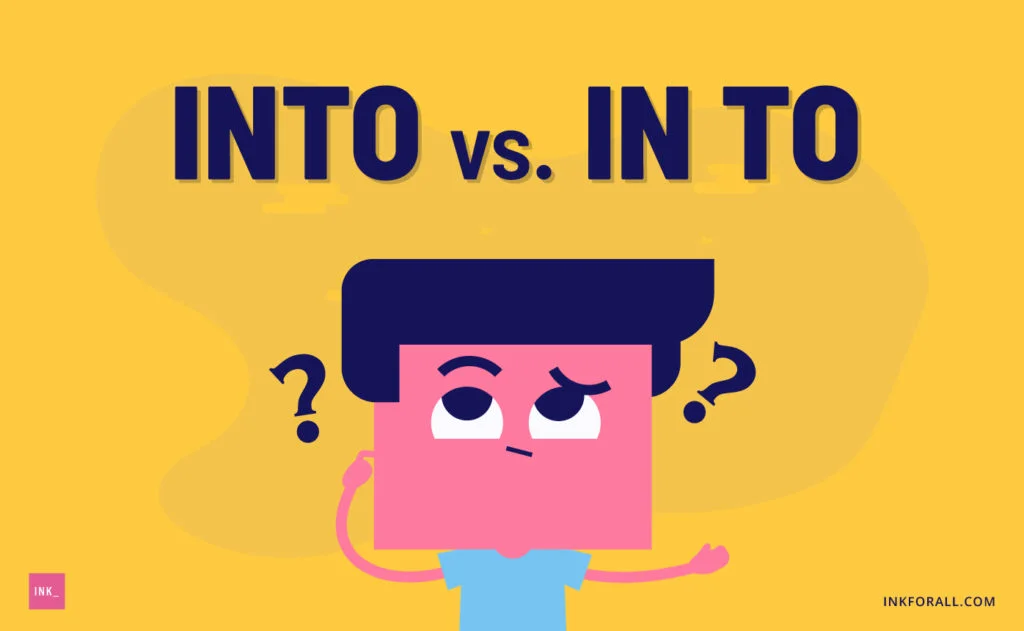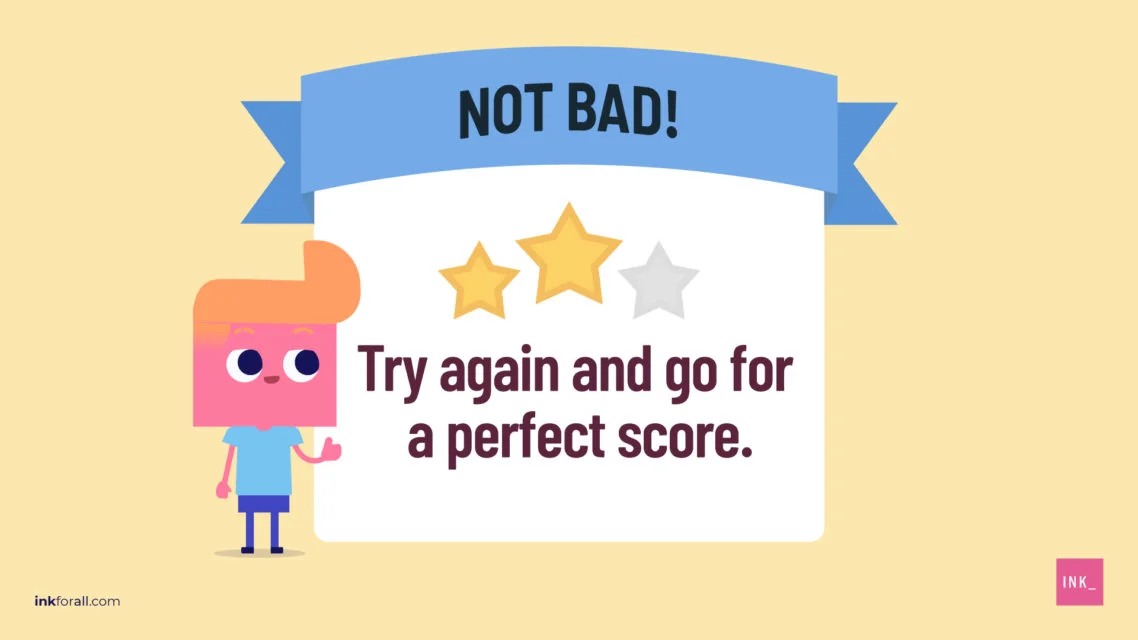Main Into vs. in to Takeaways:
- Both into and in to are correct, but they are not interchangeable. They mean different things.
- Into is one word and is a preposition. It helps illustrate physical movement (The river leads into the ocean), or a metaphorical transformation (With one kiss, she turned the frog into a prince).
- Into goes directly in front of a destination space in a sentence.
- Conversely, in and to are two distinct words. Even though they aren’t related, they sometimes end up next to each other in a sentence.
Like anytime vs. any time and to vs. too, into vs. in to is a huge source of confusion in English grammar. They look almost identical, but these two are not the same. Let’s look at the difference between them and show you when to use into or in to in a sentence.
What is the Difference Between Into and In To?
The difference betweeninto and in to comes down to the parts of speech. On one hand, use the preposition into to show that one thing physically moved inside another, or one thing figuratively transformed into another. On the other hand, in to is a two word phrase usually comprised of the adverb in followed by the preposition to. This won’t work in every situation, but use this quick trick to check yourself: if you can replace the word with “in order to,” you should probably opt for in to vs. into.
💡 Use this easy trick to make sure you choose the right one:
- Try replacing it with “in order to.”
- Does the sentence still make sense?
- If so, then in to (two words) is probably correct. If not, then into (one word) is probably correct.
Here is an example that illustrates why into and into are not interchangeable. Moreover, this example also shows how the above trick is a good guide but doesn’t work 100% of the time. So, be sure to think critically about the sentence’s meaning.
The meaning of the last two examples changes dramatically depending on whether you choose into or in to.
For example, the incorrect sentence means that the student transformed his paper into his teacher!
Since we really mean to say that the student submitted his work to his teacher for grading, the correct sentence uses the phrase in to (the adverbial phrase turn in + the prepositional phrase to the teacher).
Is It Into or In To?
Into and in to are both correct, but they mean very different things. The difference between these two comes down to the parts of speech. For example, into is a preposition. It lets us know that something is moving from one direction to another (He walked into the room). Conversely, in to is a phrase made up of the adverbin and the preposition to. These two words aren’t related. Instead, they just happen to sit next to each other in the sentence (He walked in to listen to the lecture).
On on hand, the preposition into indicates literal or metaphorical action:
- An object moves into a space.
- A person moves from adolescence into adulthood.
- A season moves from winter into spring.
On the other hand, the word in can be a preposition, an adverb, an adjective or a noun depending on the circumstances:
- Preposition:An object sits in a room.
- Adverb: A person is in crisis.
- Noun: Summer is in full bloom.
The word to can be a preposition, but it can also be an adverb — or part of an infinitive. “To” sometimes winds up next to “in” in a sentence.
Here, to is part of the prepositional phraseto the store.
In this example, to is part of the adverbial phrase “come to,” meaning to regain consciousness or to wake up.
In English, “to” always goes before an infinitive verb. This is part of the way we show that a verb is in its infinitive form and not conjugated.
When Should You Use Into or In To?
Many confuse the single word “into“ with the two-word phrase “in to.” Use the preposition intoto indicate movement, whether literal or figurative. This word shows readers that something is inside something else, or where an object is in relation to another (She poured the teaintoher mug). Next,in and to are two separate words that sometimes end up next to each other in a sentence. Therefore, you usually use in to when an adverbial phrase ends with in and a prepositional phrase or infinitive begins with to (She walked in to get some tea).
Here are examples of when to use Into vs. In To in a sentence:
How Do We Use Into in a Sentence?
In a sentence, place into right in front of the destination space: intothe car; intothe house; intothe lake. Use the word into to indicate movement from one location to another. Into is a preposition, and prepositions always indicate where things are in relation to other things.
Here are examples of when to use into in a sentence:
Are you Into or In To?
Both “are you into” and “are you in to” are correct, but have different meanings. Therefore, the correct phrase depends on what you want to say. For example, if you want to ask if someone is interested in a topic or enjoys doing a certain activity, you would use the one-word preposition into (Are you into playing sports?). However, if you want to ask the reason for someone’s visit, you would probably use the two-word phrasein to (Are you in to see the doctor?).
Is it Look Into or In To?
The correct idiom is “look into.” This means to try to discover, or uncover, the facts about a situation, like a problem or a crime. The word “into” in the phrase “look into” is a preposition, which denotes a movement toward something or a certain location. If you’re investigating something, you need to “move toward/closer” to the evidence or object of your interest to find the truth.
In the above example, the speaker is claiming that the pole is not properly attached to its base. But, his/her statement also suggests that you can prove it yourself if you look into it (look closer to the pole).
Recap: Into vs. In To
First, never use “in to” and “into” interchangeably. This is a mistake.
In fact, into is actually one word. And, it’s a preposition. As a result, it defines what an object is inside, or within. To use into correctly in a sentence, put it right in front of the destination space.
However, in and to are two completely different words, even though they sometimes wind up next to each other.
Confident you know when to use into vs. in to? Test your skills below!
Quick Into vs. In To Quiz
Into vs In to Question #1
Correct!
Wrong!
The answer is FALSE. “In” and “to” are two distinct words. Meanwhile, “into” can mean a metaphorical transformation or physical movement.
In to vs Into Question #2
A. Into
B. In to
C. All of the above
Correct!
Wrong!
The answer is A. “Into” is a preposition that tells the reader about motion or direction.
Into or In to Question #3
A. Into
B. In to
C. Any of the above
Correct!
Wrong!
The answer is A. You use “into” to indicate movement or position.
In to or Into Question #4
A. Into
B. In to
C. Any of the above.
Correct!
Wrong!
The answer is A. The preposition “into” can indicate literal or metaphorical action.
Into and In to Question #5
A. Into
B. In to
C. Any of the above.
Correct!
Wrong!
The answer is B. “In” and “to” are separate words that sometimes end up next to each other in a sentence.
In to and Into Question #6
A. Preposition
B. Adverb
C. Adjective
D. All of the above
Correct!
Wrong!
The answer is D. The word “in” can be a preposition, an adverb, an adjective or a noun.
Into vs In to Quiz Result
Expert!
Not bad!
Almost got it! Review the article and try again.
Read More: Than Vs. Then: How To Tell The Difference Once And For All
Use the prepositions TO and INTO like a native speaker, plus learn how to correctly use INTO and IN TO with your English writing.
| The preposition to can mean – in the direction of something; towards something. |
| “The ball rolled to the end of the Street.” |
| Go into or get into it means to enter or to go inside. |
| “Kevin walked into the party and started looking for his friends.“ |
| Into can also mean – in the direction of something |
| “If you stare into the sun you will damage your eyes.” |
| We can find the words in to as a combination of a phrasal verb and another verb to show purpose. |
| “I was in the neighborhood so I thought I would drop in to say good morning.” |
Language students everywhere face the same challenge – PREPOSITIONS. I struggle with Japanese prepositions myself as a language student. This struggle has helped me understand the easiest way to learn them, and as a teacher, it has shown me the best way to teach them.
With lots of natural examples!
The preposition TO is a common word that most people studying English can easily recognize. This word has different uses and meanings, but the most basic way to use it is with verbs of movement. It means:
– in the direction of something; towards something.
All definitions in this post come from Oxford Learner’s Dictionaries
We go/come or travel TO a place or an event
- I have to travel to Europe a lot for my job.
- Are you coming to my party this Saturday?
- I went to the Fuji Rock festival in 2011, it was amazing.
- Andre saw a huge dog on his way to work.
- My sister went to Venezuela for 6 months after university.
15 verbs of movement used with the preposition TO
(These examples were chosen because the verbs are followed directly by the preposition to.)
*Click the verb to learn it’s meaning at Oxford Learner’s Dictionaries
| Verb | Example sentence |
|---|---|
| drive | My friend and I drove to Florida when we were in high school. |
| get | How do you get to Tokyo station? |
| go | Are you going to the class picnic this Saturday? |
| jog | I jog to school when the weather is nice. |
| limp | After the tackle, Zachary stood up slowly and limped to the bench. |
| move | I’m moving to a new house in October. |
| on one’s way | Can you drop me off at school on your way to work? |
| roll | The ball rolled to the end of the Street. |
| rush | After work, I rushed to my daughter’s school to watch her in the school play. |
| run | We got scared so we ran to our friend’s house. |
| sprint | In the final stretch of the race, Denise sprinted to the finish line. |
| stagger | Derek set his beer down, got off his stool, and staggered to the bathroom. |
| swagger | Feeling very confident Peter swaggered to the front of the class. |
| tiptoe | I didn’t want to wake my wife so I tiptoed to the kitchen to get a midnight snack. |
| walk | I usually walk to school but sometimes I take the bus. |
The preposition TO with the noun trip and the Passive Voice
Sometimes need to use the preposition TO with the noun trip.
- We take a family trip to Ottawa every summer to visit my grandparents.
- Jessica is planning a trip to Spain next Spring.
- How was your trip to Ireland?
We also use the passive voice with verbs of movement if the person WAS MOVED somewhere.
Passive voice uses the verb to be (am, is, are, was, were) plus the past participle form of the verb in the main action.
- After the accident, he was taken to the hospital.
- The president’s plane was late due to poor weather. As soon as he landed he was rushed to the summit.
- Gregory was a noisy student. He was moved to the front of the class so the teacher could keep an eye on him.
Some more verbs of movement that are used in the passive voice with the preposition to. These verbs are in the past participle form.
- Airlifted – an operation to take people, soldiers, food, etc. to or from an area by aircraft, especially in an emergency or when roads are closed or dangerous
The crash victim was airlifted to the nearest hospital.
- Brought – to come to a place with somebody/something
The suspect was brought to the courthouse from the local jail.
- Carried – to support the weight of somebody/something and take them or it from place to place; to take somebody/something from one place to another
The medical staff came on the field and the player was carried to the locker room.
- Shipped – to send or transport somebody/something by ship or by another means of transport
The equipment was shipped to the factory this morning.
The preposition INTO – meaning
When we say go into or get into it means to enter or to go inside.
- The president went into the conference room and started talking to the other world leaders. (The president entered the conference room)
- Kevin walked into the party and started looking for his friends. (Kevin entered the party)
- A mouse got into my house through a hole in my basement. (A mouse went inside my house)
- I put the shoes back into the shoebox so they wouldn’t get damaged. (I put the shoes inside the box)
- Somebody broke into our office last night and stole my laptop. (Someone forced entry to our office) BREAK IN and BREAK UP (Video + QUIZ)
The preposition IN can be used by itself sometimes too.
- 3 girls came into the store.
- 3 girls came in the store.
One meaning of INTO is very similar to the preposition TO.
– in the direction of something
But this meaning of INTO is not used with verbs of movement. Here are 3 examples:
- Please speak directly into the mic.
- If you stare into the sun you will damage your eyes.
- I looked into her eyes and I felt she was being sincere.
Speak, stare and look are not verbs of movement. A microphone, the sun and her eyes are not places we move to. INTO is used more with places of focus.
– Speak directly (focus your voice) INTO the microphone.
– If you stare (focus your eyes) INTO the sun you will damage your eyes.
– I looked (focused deeply) INTO her eyes and I felt she was being sincere.
Verbs used with the preposition INTO
Here are some verbs that are commonly used with the preposition INTO.
- To meet or make contact with
| bump | I bumped into my boss’s wife at the supermarket. |
| crash | The truck crashed into a traffic light. Luckily no one was hurt. |
| run | I ran into my boss’s wife at the supermarket. |
- To put something into two or more parts
| cut | The cake was cut into eight slices. |
| divide | The homeowner divided his basement into two parts. He made separate bedrooms for his two sons. |
| split | The woodsman swung his axe and split the wood into 2 pieces. |
- To change from one language INTO another
| translate | This book is very popular. it has been translated into eight languages. |
Many of my private and group lesson students have been confused when they see a sentence that has the words IN and TO next to each other. They feel like they should always be written as one word – INTO. This is not correct. Let me show you how to know which pattern to use.
In English, we often use Phrasal Verbs. A phrasal verb is a verb plus a preposition and many phrasal verbs are made with the preposition IN.
Here are some examples:
- Drop in – to pay an informal visit to a person or a place
I was in the neighborhood so I thought I would drop in to say good morning.
*To say is the infinitive form of the verb SAY. The preposition TO is showing purpose in this sentence. To say good morning is the reason we dropped in. INTO is not correct here.
- Log in – to perform the actions that allow you to begin using a computer system, application, or online account
My friend is addicted to Social media. As soon as he wakes up he logs in to his Facebook account before he even gets out of bed.
Learn and use 50 Common Phrasal Verbs – video+PDF
*NOTE*
Login is written as one word when it is used as a noun.
Please enter your login ID to continue.
Log in is a phrasal verb that means that you connect to a machine (such as a host, server, workstation and so on) or authenticate to a user interface by providing your credentials. In this case, to is a preposition that links the phrasal verb to the upcoming word. – That is why the correct spelling is log in to not
log into.https://helpcenter.veeam.com/docs/styleguide/tw/log_in_to.html
To, Into, In to Conclusion
The preposition to can be used with verbs of movement. Go into or get into it means to enter or to go inside. We can find the words in to as a combination of a phrasal verb and another noun or to show purpose.
Has today’s blog post been helpful for you to understand the difference between these prepositions? Be sure to check out my other preposition blog posts, videos, and more. Have a look at my Resource page too for more helpful English tools, courses and freebies.
Thanks to
For those interested in a little info about this site: it’s a side project that I developed while working on Describing Words and Related Words. Both of those projects are based around words, but have much grander goals. I had an idea for a website that simply explains the word types of the words that you search for — just like a dictionary, but focussed on the part of speech of the words. And since I already had a lot of the infrastructure in place from the other two sites, I figured it wouldn’t be too much more work to get this up and running.
The dictionary is based on the amazing Wiktionary project by wikimedia. I initially started with WordNet, but then realised that it was missing many types of words/lemma (determiners, pronouns, abbreviations, and many more). This caused me to investigate the 1913 edition of Websters Dictionary — which is now in the public domain. However, after a day’s work wrangling it into a database I realised that there were far too many errors (especially with the part-of-speech tagging) for it to be viable for Word Type.
Finally, I went back to Wiktionary — which I already knew about, but had been avoiding because it’s not properly structured for parsing. That’s when I stumbled across the UBY project — an amazing project which needs more recognition. The researchers have parsed the whole of Wiktionary and other sources, and compiled everything into a single unified resource. I simply extracted the Wiktionary entries and threw them into this interface! So it took a little more work than expected, but I’m happy I kept at it after the first couple of blunders.
Special thanks to the contributors of the open-source code that was used in this project: the UBY project (mentioned above), @mongodb and express.js.
Currently, this is based on a version of wiktionary which is a few years old. I plan to update it to a newer version soon and that update should bring in a bunch of new word senses for many words (or more accurately, lemma).
Into, or “in to”? Onto, or “on to”?
Into and onto are prepositions, words that describe relative position. They are part of prepositional phrases, such as “She settled herself into her seat” or “He climbed onto the roof.” These words are forward looking, in that, as their grammatical name implies, they are positioned before the object.
“In to” and “on to,” on the other hand, are combinations of an adverb (in or on) and the preposition to. Unlike the single-word forms, they look both backward (in and on refer to a preceding verb) and forward (to pertains to the following object).
Of the distinctions between each pair, that distinguishing into from “in to” is more straightforward. If you wish to write that you went somewhere to let a representative of a company know you are disappointed with a product or service, you can express that idea using either form. But if you write, “I walked into the office to lodge a complaint,” the sentence focuses on the prepositional phrase “into the office.” If you write, “I walked in to lodge a complaint,” the emphasis is the phrase describing the action: “I walked in.”
Onto and “on to” can be more confusing, but think of the problem this way: “She drove onto the highway” means, “She drove so that she was on the highway.” Conversely, “She drove on to the highway” means, “She headed for the highway.” The two-word form is also appropriate for figurative meanings, where no physical movement or placement exists — for example, “I think you’re really on to something.”
Fortunately, there are a couple of ways to test whether onto or “on to” is correct — temporarily insert the word up after the verb, or, just for the test, replace the word or the phrase with the word on:
The “Up” Test
When you wish to write that you used a ladder, could you write, “I climbed up onto the ladder”? Yes, you could, so onto is correct. When you want to express that you clutched something, could you write, “I held up on my hat”? No, the sentence does not make sense, so the two-word form (“I held on to my hat”) is the right one in this case.
The “On” Test
When you wish to write that you scaled a boulder, could you write, “I climbed on a boulder”? Yes, you could, so onto is correct. When you want to express that you bequeathed something, would you write, “I passed it on him”? No, that doesn’t make sense, so the two-word form (“I passed it on to him”) is correct here.
Предлоги в английском языке
Автор: Татьяна Пелых Раздел: Грамматика, Части речи в английском Дата публикации: 05.09.2020
Предлогами называются служебные слова, которые выражают отношение между словами в предложении. Предлоги играют очень важную роль, являясь одним из способов выражения падежных отношений между членами предложения. В русском языке 6 падежей, а в английском только два падежа:
- общий (Common Case)
- притяжательный (Possesive Case)
В связи с отсутствием падежных окончаний в английском языке, функцию отношений между словами чаще всего выполняют предлоги.
Сопоставление английских предлогов с русскими падежами
Предлог of в сочетании с существительным или местоимением соответствует русскому родительному падежу (кого? чего?)
The kitchen of their house is still being redecorated.
Кухня их дома все еще ремонтируется.
Look! My new office building is at the end of this street.
Смотрите! Мое новое офисное здание в конце этой улицы.
Предлог to в сочетании с местоимением или существительным соответствует русскому дательному падежу (кому? чему?)
He explained the grammar to the students again.
Он снова объяснил грамматику ученикам.
Предлог by соответствует русскому творительному падежу (кем? чем?).
My son was praised by the principial for passing his Maths test.
Мой сын получил похвалу от директора за то, что он сдал экзамен по математике.
Предлог with также соответствует русскому творительному падежу (кем? чем?), обозначая предмет, которым производится действие.
An old lady was hit with an umbrella in a bus.
Старушку ударили зонтиком в автобусе.
В рассмотренных выше примерах предлоги утрачивают свое лексическое значение и не переводятся на русский язык.
Рассмотрим наиболее часто употребляемые предлоги: in, at, on, to, from, into. Их вы могли изучать в школьной программе и часто можете встретить почти в любом английском тексте.
Эти предлоги, особенно in, at, on могут быть предлогами:
- места (at home, at school)
- времени (at 3 p.m, at midnight)
- входить в состав устойчивых выражений (at the age of, at Christmas)
- образовывать ряд сочетаний с существительными, прилагательными, глаголом, наречиями (be good at, be suprised at/by, in cash, on a diet, on foot, on holiday/on business)
Предлог in обычно переводится «в» и встречается в предложениях, отвечающих на вопрос где?
They are in London. He is in the garden. She is in the kitchen.
Они в Лондоне. Он в саду. Она на кухне.
Предлог at обычно переводится «в, у, на, при» и отвечает на вопрос «где?», но имеет более широкое значение чем in. Если предлог in обычно значит «в пределах чего-то, внутри», то at определяет местонахождение чего-либо и часто образует устойчивое сочетание с существительным или с глаголом. В разных примерах предлог at переводится на русский по разному.
Look, my daughter is at the computer table.
Смотри, моя дочь за компьютерным столом.
Children, please write down your names at the top of your lists.
Дети, пожалуйста, запишите свои имена вверху списков.
Father is at home, mother is at the cinema.
Отец дома, мать в кинотеатре.
Hey boys, look at the blackboard.
Эй, мальчики, посмотрите на доску.
Предлог on употребляется как предлог места и отвечает на вопрос «где? на чем?», чаще всего переводится «на», но также имеет и много других значений.
The English books are on the coffee table, the French books are on the shelf.
Английские книги на журнальном столике, французские — на полке.
Where are the clean plates? They are on the table in the kitchen.
Где чистые тарелки? Они на столе на кухне.
Предлог to часто передает направление движения и переводится «в», «к» или «на».
Go to the blackboard.
Иди к доске.
We are going to move to a new house.
Мы собираемся переехать в новый дом.
Take these children to the lake.
Отведи этих детей на озеро.
My Grandparents are coming to our place tomorrow.
Мои бабушка с дедушкой приезжают к нам завтра.
Предлог to также может передавать отношения выражаемые в русском языке дательным падежом.
I should give my love to your parents.
Мне надо выразить свою признательность твоим родителям.
I can give some sound advice to your son if he wants to listen to me.
Я могу дать вашему сыну хороший совет, если он захочет меня выслушать.
Предлог from обычно переводится «от, из, с».
Peter comes from Russia.
Питер родом из России.
My father is travelling from Poland.
Мой отец едет из Польши.
I get this secret news from Marina.
Я получаю секретные новости от Марины.
Take away this dirty plates from my table.
Убери эти грязные тарелки со стола.
Предлог into обозначает движение внутрь (inside) чего-то и обычно переводится «в»; отвечает на вопрос «куда? во что?».
Put your right hand into the liquid and wait for 3 min.
Положите правую руку в жидкость и подождите 3 минуты.
Look, it looks like rain. Go into the building.
Смотри, похоже на дождь. Иди в здание.
Ice turns into water at 0 degrees.
Лед превращается в воду при 0 градусах.
Translate it into Russian.
Переведи на русский.
This plan must be taken into account.
Этот план должен быть принят во внимание.
Внимание! При работе с текстом никогда не переводите предлоги механически.
Необходимо серьезно вдумываться в значение каждого английского предлога и стараться подобрать подходящий по смыслу перевод.
Особенно важно уметь употреблять разные части речи с устойчивыми предлогами:
- need for (The noun)
- part with (The verb)
- according to (The preposition)
- capable of (The adjective)
- enter into (start) (The verb)
- in the event of (групповой предлог) — «в случае если»
Полный список слов с устойчивыми предлогами необходимо изучать и практиковать довольно длительное время.
Заключение
В этом уроке мы рассмотрели наиболее часто употребимые английские предлоги in, at, on, to, from, into. В английском языке всего два падежа (следовательно, у слов нет множества всевозможных окончаний (как в русском), которые помогают их увязывать одно с другим), поэтому предлоги в значительной степени берут на себя функцию передачи отношений между словами.
Если у вас остались вопросы по теме урока — задавайте их в комментариях ниже.
Упражнения на грамматику
Задавайте вопросы в комментариях
статьи по грамматике
Автор
Татьяна Пелых
Здравствуйте, меня зовут Татьяна. Я преподаю английский язык студентам, школьникам и взрослым, начавшим изучать язык с нуля. Готовлю к выезду за границу, к сдаче экзаменов и тестов.
Пишу уроки и упражнения для EnglishPlan.ru. Буду рада ответить на ваши комментарии к моим урокам. Желаю Вам успеха!












